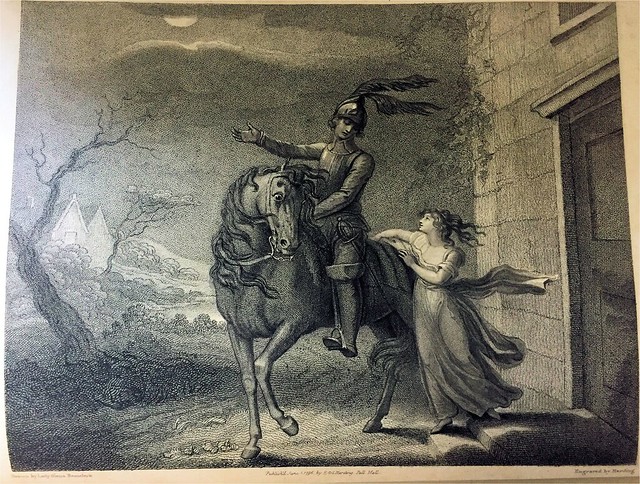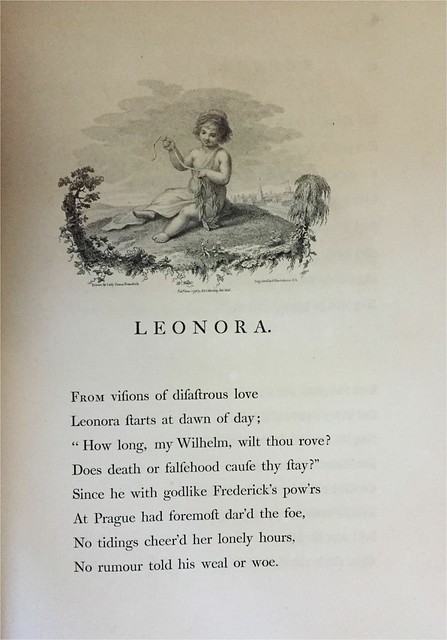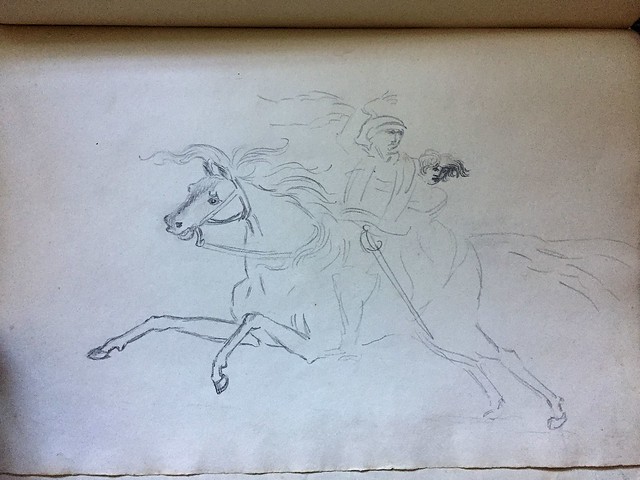This article is more than 5 years old.
If you’re feeling Gothic in 2017, you’ll have an extra month to visit ZSR’s classic works of Gothic lit like The Castle of Otranto, Frankenstein, and Dracula. The ZSR Special Collections exhibit Deep Into that Darkness Peering has been extended until March 1. Stop by Special Collections & Archives (ZSR 625) any time during our regular hours of 9:00-5:00, Monday-Friday, or contact us to arrange evening or weekend viewings and group visits.
One of the most visually striking items in the exhibit is an illustrated folio translation of Gottfried August Bürgher’s ballad “Lenore.”

In Bürgher’s poem, first published in Germany in 1774, the title character is a young woman whose fiance, Wilhelm, has failed to return from battle in the Seven Years War. Lenore is inconsolable, assuming that he is either dead or unfaithful, and she rails against God’s unfairness. But then Wilhelm arrives on horseback in the night and summons Lenore to join him in a journey.

They travel through an increasingly terrifying landscape, until finally Lenore’s spectral lover is revealed to be Death himself.

“Lenore” was tremendously popular and had great influence on writers of Gothic literature in England as well as Germany.
The 1796 English translation on exhibit in ZSR Special Collections was illustrated by Lady Diana Beauclerk and translated by her nephew, William Robert Spencer.

Diana Beauclerk was an aristocratic Englishwoman with an artistic bent. Born Lady Diana Spencer in 1734 (her brother was ancestor to the other Lady Diana), she had an unhappy first marriage to Frederick, Lord Bolingbroke. They eventually divorced—an unusual occurrence at the time—and Diana married Topham Beauclerk. She befriended many of the artistic and cultural lights of the time, including Horace Walpole, Samuel Johnson, and Georgiana Cavendish. After the death of her second husband, Diana devoted more time to her drawing and painting, in part as a means of improving her financial situation.

She specialized in portraits and illustrations for works such as Walpole’s Mysterious Mother, John Dryden’s Fables, and The Faerie Queene. Many of her illustrations and individual works were reproduced for sale by the famous engraver Francesco Bartolozzi. She also created designs for the Wedgwood pottery.

The 1796 edition of Leonora came about when J. T. Stanley, a family friend, lent Diana his translation of Bürgher’s poem in manuscript. Shortly thereafter a large edition of appeared, with illustrations by Diana and parallel text in German and in English translation.

Diana’s nephew, William Spencer, was credited with the translation, but Stanley claimed that Spencer had merely tweaked his version. and published it without permission. Stanley came out with his own translation that same year, as did the English poet laureate, Henry James Pye. But Diana Beauclerk’s illustrated edition captured the public imagination, and her illustrations became iconic images of the Gothic romance in the 1790s. The copy of Leonora in ZSR Library’s Special Collections was originally owned by woman named Charlotte King. She many have been the one who, inspired by Diana Beauclerk’s illustrations, left this original sketch on the endpapers.

Leonora is on exhibit in ZSR Special Collections & Archives through March 1, 2017.

1 Comment on ‘Picturing the Gothic: “Leonora,” by Gottfried Augustus Bürgher, illustrated by Diana Beauclerk (1796)’
What fantastic illustrations, and insightful summary. Thanks for posting this. I’m feeling a little Gothic myself just now.